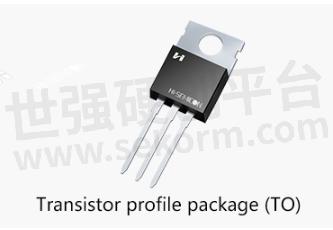To Prevent MOS Tube from Burning, We Need to Know Why it Burns First

MOS working state in the controller circuit: on process (transition process from conduction to cut-off), on state, off process (transition process from conduction to cut-off), and cut-off state.
The MOS major losses also correspond to the following states: switch losses (on and off), conduction losses, cut-off losses (caused by leakage current, which is ignored), and avalanche energy losses.
As long as these losses are controlled within the MOS tolerance specifications, MOS will work normally, beyond the tolerance range, that is, damage will occur. However, the switching loss is usually larger than the on-state loss, which may vary greatly with different MOS.
MOS damage cause
Main causes of MOS damage:
Overcurrent - Burn out due to excessive junction temperature caused by continuous large current or instantaneous large current.
Overvoltage -- source leakage overvoltage breakdown, source gate overvoltage breakdown.
Static electricity - static electricity breakdown, CMOS circuit are static.
MOS switch principle
MOS is a voltage driven device. As long as the gate and the source level give an appropriate voltage, the source level and leakage level path will be formed. The resistance of this current path is known as MOS internal resistance, that is, the on resistance . This internal resistance basically determines the maximum conduction current that MOS chip can withstand (of course, it is related to other factors, the most important is thermal resistance), and the smaller the internal resistance is, the larger the current will be (because of the small heating).

Fig.1
Prevent MOS from burning down
The MOS problem is not so simple. There is equivalent capacitance between the gate and the source, between the source and the drain, and between the gate and the drain. Therefore, the process of charging the grid voltage is the process of charging the capacitor (capacitor voltage cannot be suddenly changed), while the switching process between MOS source level and leakage level from cutoff to conduction is restricted by the charging process of the grid capacitor.
However, these three equivalent capacitors form a series and parallel combination relationship, they affect each other, and are not independent, if independent is very simple.
One of the key capacitors is the CGD capacitor between the gate and drain stage, which is known in the industry as miller capacitor. This capacitance is not constant and varies rapidly with the voltage between the gate and drain stage. This Miller capacitor is a stumbling block to gate and source-level capacitor charging, as the gate charging CGS of the grid-source capacitor reaches a platform, and the charging current of the gate must charge miller capacitor CGD. At this point the voltage between the gate and the source level is no longer rising, and it reaches a platform, and this is the Miller platform (the miller platform is the process of charging CGD), and the first thing that comes to mind for miller platform is miller oscillation. (That is, the gate first charges the CGS, and then charges the CGD after reaching a certain platform).
At this time, the voltage between the source stage and the leakage stage changes rapidly, and the internal capacitor charges and discharges rapidly accordingly. These current pulses will cause the MOS parasitic inductance to produce great inductance. There is a shock circuit composed of capacitance, inductance and resistance (which can form two loops), and the stronger the current pulse, the higher the frequency and the larger the oscillation amplitude. Therefore, the most critical problem is how to transition this Miller platform.
Gs electrode add capacitance, slow down the conduction time of MOS tube, help to reduce Miller oscillation. Prevent MOS tube from burning out.
Too fast charging will lead to intense Miller oscillation, but too slow charging will reduce the oscillation but prolong the switch and increase the switch loss. The equivalent resistance between the circuit source stage and the leakage stage is equivalent to a transition process from an infinite resistance to a conduction internal resistance with a very small resistance value (the conduction internal resistance of low-voltage MOS is only a few milliohms in general).

Fig.2
For example, the maximum current of a MOS is 100A and the battery voltage is 96V. During the opening process, for a moment (just when entering Miller platform), the heating power of MOS is P=V*I(at this time, the current has reached the maximum and the load has not run yet, all the power falls on the MOS tube), P=96*100= 9600W! At this time, its heating power reaches its maximum, and then the heating power decreases rapidly until the power becomes 100*100*0.003= 30W at the time of complete conduction (it is assumed that the MOS conduction internal resistance is 3 milliohms here). The change of heating power during the switching process is amazing.
If the opening time is slow, it means that the heating transition from 9600W to 30W is slow, and the MOS junction temperature will rise sharply. Therefore, the slower the switch is, the higher the junction temperature will be and the MOS will be easily burned. In order not to burn MOS, the MOS current limit can only be reduced or the battery voltage reduced. For example, limit it to 50A or reduce the voltage by half to 48V, so that the heat loss of the switch is also reduced by half and the pipe is not burned.
This is also the reason why high voltage control is easy to burn the pipe. Only the switch loss is different between high voltage controller and low voltage (the switch loss is basically proportional to the battery terminal voltage, assuming the same current limit). The conduction loss is completely determined by MOS internal resistance and has nothing to do with the battery voltage.
In fact, the whole MOS opening process is very complex. There are too many variables. In a word, it is not easy for Miller to shock when the switch is slow, but the switch loss is large, the pipe is hot, and the switch speed is fast. In theory, the switch loss is low (as long as miller shock can be effectively suppressed). However, miller often has a severe shock (if miller has a severe shock, the pipe may be burned on Miller platform). On the contrary, the switch loss is also large, and the upper arm MOS shock is more likely to cause the lower arm MOS to misdirect, forming a short circuit in the upper and lower arms.
So this is a test of the designer's drive circuit wiring and master circuit wiring skills. Finally is to find a balance point (generally the opening process is not more than 1US). The opening loss is the simplest one, which is only proportional to the on-resistance. If the current is large and the loss is low, the internal resistance should be low.
The following points are useful for ordinary users
The important parameters selected by MOS are briefly explained, for example, datasheet.
Gate charge: QGS, QGD.
QGS : It refers to the total charge charged by the gate from 0V to the corresponding current Miller platform (the actual current is different, the platform height is different, the higher the current, the higher the platform, the larger the value). This stage is to charge the CGS (also equivalent to the CISS, input capacitance).
QGD : Refers to the total charged charge of the entire Miller platform (here referred to as the Miller charge). This process charges the CGD (CRSS, a capacitor that changes rapidly with the GD voltage).
In switch overshoot, the main heating interval of MOS is the stage marked in bold red. Starting from VGS, the threshold voltage is exceeded, and the main heating interval is at the end of Miller platform. After the completion of Miller platform, the MOS basically opens up, and then the loss is the basic on-off loss (the lower the MOS internal resistance, the lower the loss).
Before the threshold voltage, MOS is not turned on and there is almost no loss (only a little loss caused by leakage current). Among them, the red bend has the biggest loss (QGS charging is almost over, and the heating power is the largest during the process of approaching miller platform and just entering Miller platform (thicker line).
Therefore, if the charging current is certain, the tubes marked in red with small total charge will pass quickly, so that the heating interval time will be short and the total calorific value will be low. Therefore, in theory, the MOS tube with small QGS and QGD size can pass through the switching zone quickly.
Conduction internal resistance: RDS (ON); The lower the pressure, the better. Nevertheless different manufacturer mark internal resistance has different test condition. The measured value of internal resistance will be different under different test conditions. For the same pipe, the higher the temperature is, the greater the internal resistance will be (this is the characteristic of silicon semiconductor material in MOS manufacturing process, which cannot be changed and can be slightly improved). Therefore, the internal resistance of the large current test will increase (the junction temperature of the large current will increase significantly), and that of the small current or pulse current test will decrease (because the junction temperature does not increase significantly and there is no heat accumulation).
- +1 Like
- Add to Favorites
Recommend
- Details of MOS tube packaging
- The Differences between MOS Tube and IGBT Tube
- MOS Tube Drive Circuit Summary - Detailed Design of Various Switching Power Supply MOS Tube Drive Circuit
- Explain in Detail the Cause of MOS Tube Heating
- What is the Difference between MOS tube and IGBT?
- MOS Tube Knowledge, Must Read!
- How to Judge the Working State of MOS Tube?
- MOS Tube Anti-overvoltage Circuit
This document is provided by Sekorm Platform for VIP exclusive service. The copyright is owned by Sekorm. Without authorization, any medias, websites or individual are not allowed to reprint. When authorizing the reprint, the link of www.sekorm.com must be indicated.






























































































































































































































































































































































































































































































































































































































































































































































































































































































